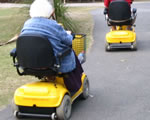 Go to main content
Go to main content
Archive Website of the UK government
Please note that this website has a UK government accesskeys system.
Main menu
Page menu
Disabled people

Using a mobility scooter or powered wheelchair

You have to follow the rules of the Highway Code, whether you are using the footpath or the highway. Following some safety tips will help you keep safe and keep your vehicle in good condition.
Training
You should get some training if you are using a powered mobility vehicle for the first time, or haven't used one in a while. For details of courses, contact your nearest Disabled Living Centre or Mobility Centre, or your local council's Road Safety Unit.
Rules and safety tips
You have to follow the rules of the Highway Code. Look at a current edition of the Highway Code and learn the various traffic signs and signals you may come across when you're driving.
There is no legal eyesight requirement, but you should be able to read a car's registration number from a distance of 12.3 metres (40 feet). You must monitor your ability to do this regularly while you use a class 3 vehicle.
The vehicle's horn should not be used between 11.30 pm and 7.00 am. And it should not be used when the vehicle is not moving, unless there is danger from another moving vehicle. Only use the horn to warn other road users that you are there – do not use it as a greeting or to show anger.
If the vehicle has a lap belt fitted to it, always use it - even for short journeys.
You should wear fluorescent clothing during the day and something reflective at night. This will help others to see you. Do not wear dark clothes at night.
Plan your journeys carefully. This may help you to avoid major roundabouts or busy roads. If the situation on the road becomes too daunting, you can always switch to footpath mode and move to the pavement.
On footpaths
Show consideration for and give way to pedestrians.
Class 3 vehicles can legally travel at four miles per hour (mph) on footpaths or in pedestrian areas. But it's not always safe to travel at this speed. Adjust your speed according to the circumstances. See 'Mobility scooters for road use' to find out what a class 3 vehicle is and for more details about the classes of vehicles.
You can take advantage of pelican and zebra crossings when in four mph mode in order to cross from one footpath to another.
When moving off the footpath on to the road, take special care. Before moving off, always look round and make sure it is safe to join the traffic. Watch out for cyclists in particular.
On the road
When on the road, drive with due care and attention, always travelling in the direction of the traffic, obeying traffic signs and signals. Give way to pedestrians who are crossing at junctions or pedestrian crossings.
Watch out for obstructions in the road ahead, such as drains, pot-holes and parked cars. When passing parked cars, watch out for doors being opened in your path or the vehicle moving off without indicating.
Bear in mind that other drivers may not be able to see you easily. As a class 3 vehicle driver, you are in a similarly vulnerable position to cyclists, especially at roundabouts and junctions.
Road junctions and roundabouts
Take extra care at junctions. When going straight ahead at road junctions, check to make sure there are no vehicles about to cross your path.
When turning right, if moving into the middle of the road is difficult, you can stop on the left side of the road. Then wait for a safe gap in the traffic. You can also negotiate the turn as a pedestrian by switching to pavement mode and travelling between footways.
When negotiating major roundabouts, it may be safer to stay in the left lane, even when you are carrying on. Treat each exit you cross as a junction. Alternatively, it may be safer to switch to pedestrian mode and use the footway or to find a route which avoids the roundabout.
Parking
All normal parking restrictions apply. Your vehicle should not be left on the footways unattended if it causes an obstruction to other pedestrians. This includes wheelchair users and those with prams or pushchairs.
Keeping your vehicle roadworthy
It is essential that you keep your vehicle in good working order in line with the manufacturer's recommendations. Your vehicle should undergo a thorough safety check at least once a year.
If the vehicle has a battery, make sure that it is kept in good condition. Keep lighting equipment clean and in good working order. Windows, windscreens and mirrors should also be clean and clear of obstructions for good all-round vision.
Vehicle suppliers should be able to answer any questions you might have about the maintenance of specific models.
Further advice
For further advice about using a mobility scooter or powered wheelchair, see 'Mobility scooters and powered wheelchairs on the road - Department for Transport (DFT) website'.
 Facebook
Facebook Twitter
Twitter StumbleUpon
StumbleUpon Delicious
Delicious Reddit
Reddit